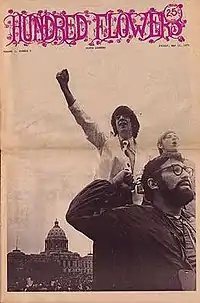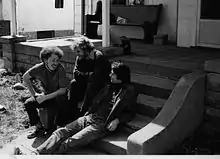Hundred Flowers (newspaper)
Hundred Flowers was an underground newspaper published in Minneapolis, Minnesota from April 17, 1970 to April 4, 1972. It was produced by a communal collective, with the main instigator being antiwar activist and former Smith College drama instructor Ed Felien. The 16-page, two-color tabloid was published weekly (later biweekly) and cost 25 cents, circulating about 5000 copies.[1]
 Cover of vol. 1, no. 5 (May 15, 1970) | |
| Type | Underground press weekly |
|---|---|
| Format | Tabloid |
| Owner(s) | Collective |
| Publisher | collective |
| Editor | collective |
| Founded | 1970 |
| Headquarters | Minneapolis, MN |
| Circulation | 5,000 |
History
Hundred Flowers was a blend of antiwar radical activism and civil rights, with hippie counterculture, with special issues devoted to the Women's Liberation and Gay Liberation movements and to the Black Panther Party. Founders, members of the staff collective and contributors included SDS/gay activist Brian J. Coyle (who later became Minneapolis' first openly gay city council person), Warren Hanson (who later founded the Greater Minnesota Housing Fund, and co-founded Fresh Air Community Radio aka KFAI-FM and Community Reinvestment Fund USA), Tom Utne (graphic artist & brother of Eric Utne, publisher of the Utne Reader), Richard Dworkin, Marly Rusoff (who later founded The Loft Literary Center), Ralph Wittcoff (a co-founder of the New Riverside Cafe), Rosemary Pierce, and many others. Ed Felien went on to serve on the Minneapolis City Council and to establish South Side Pride, a successful South side newspaper and news blog.
For at least the first 8 months of its existence the core group lived in a staff commune.[2][3]
A financial breakdown published in an early issue reported that Hundred Flowers had to gross between four and five hundred dollars a week to break even, with about half the money coming from advertising and the other half coming from sales by casual street vendors, which were coordinated through three local head shops which served as distribution points. Half the money went to pay for printing and the other half paid the rent, utilities and food bills of the staff commune.
After its 19th issue Hundred Flowers could no longer find a printer with the necessary web-fed press anywhere within a 150-mile radius who was willing to print the paper, and the staff were forced to go to Port Washington, Wisconsin to get the paper printed by William Schanen ("by mid-1969, his was the only print shop between Iowa City and Kalamazoo willing to handle underground papers"),[4] who was printing the Chicago Seed, Milwaukee Kaleidoscope and about half the underground papers in the Midwest.[5] the paper was also printed at the Red Wing Republican Eagle (a Libertarian press) in Red Wing, Minn., and the Pipestone County Star in Pipestone, Minn., for a few issues.
By its 30th issue published December 11, 1970, the collective parted ways with Ed Felien as a result of political statements published by Felien that were in conflict with principles held by other members of the collective. The publication was relaunched as a biweekly from January 29, 1971 to May 1, 1971, and then as a weekly from June 4, 1971 to Dec. 3, 1971 (vol. 2, no. 33). The paper continued to be published irregularly until April 4, 1972.[6] Beginning in 1970, the paper was published from offices above Liberty House (operated by Marv Davidov, founder of the Honeywell Project) at the corner of 6th Street and Cedar Avenue in the "West Bank" neighborhood near the University of Minnesota campus. Liberty House also housed the People's Pantry food co-op, the catalyst for the "new wave" food co-op movement in Minnesota. Several of the Hundred Flowers collective went on to co-found various Twin Cities "new wave" food co-ops throughout the 1970s and 1980s, including North Country Food Co-op, People's Company Bakery, the New Riverside Cafe, West Bank Co-op Grocery, West Bank Co-op Pharmacy, Mill City Food Co-op, People's Warehouse, as well as the Twin Cities Women's Union, Haymarket Press, and KFAI-FM aka Fresh Air Radio, among other community enterprises.

References
- "About Hundred flowers. [volume] (Minneapolis, Minn.) 1970-1972". Library of Congress. Retrieved February 6, 2020.
- "The Decline and Fall of the Local Newspaper" Archived 2010-10-01 at the Wayback Machine by Ed Felien. Twin Cities Daily Planet, Feb. 6, 2007. Retrieved July 15, 2010.
- "Hundred Flowers Staff and Distribution Info" From issue #11. Retrieved July 15, 2010.
- Uncovering the Sixties: The Life and Times of the Underground Press by Abe Peck (New York: Pantheon, 1985), p. 191. Other underground papers printed by Schanen included Brick Yard Bauls (West Lafayette, Indiana) and Counterpoint (Stevens Point, Wisconsin).
- "Let a hundred Flowers Blossom, Let a Hundred Schools of Thought Contend" by Ed Felien, Voices from the Underground: Insider Histories of the Vietnam Era Underground Press, ed. Ken Wachsberger (Tempe, AZ: Mica's Press, 1993), p. 305-312.
- About this newspaper: Hundred flowers Chronicling America, Library of Congress, retrieved July 15, 2010.